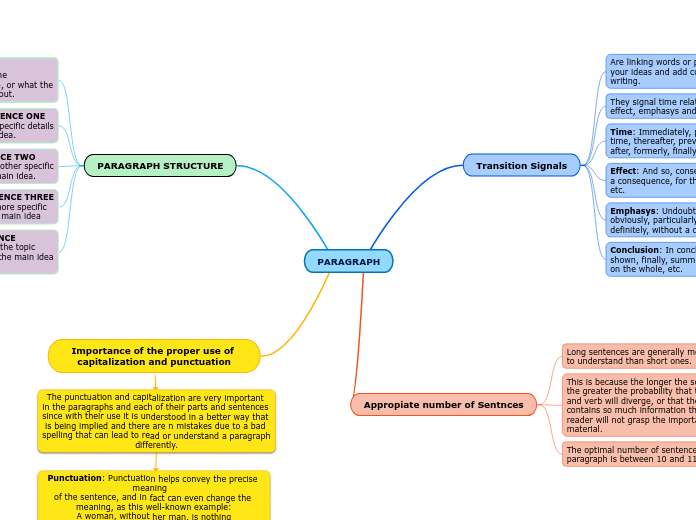PARAGRAPH
PARAGRAPH STRUCTURE
TOPIC SENTENCE
This sentence tells the
reader the main idea, or what the
paragraph will be about.
SUPPORTING SENTENCE ONE
This sentence gives specific details
relating to the main idea.
SUPPORTING SENTECE TWO
This sentence gives another specific
detail relating to the main idea.
SUPPORTING SENTENCE THREE
This sentence gives more specific
details relating to the main idea
CONCLUDING SENTENCE
This sentence refers to the topic
sentence and sums up the main idea
of the paragraph.
Transition Signals
Are linking words or phrases that connect your ideas and add cohesion to your writing.
They signal time relationship, examples, effect, emphasys and conclusion.
Time: Immediately, prior to, then, at that time, thereafter, previously, soon, before, after, formerly, finally, during, etc.
Effect: And so, consequently, therefore, as a consequence, for this reason, as a result, etc.
Emphasys: Undoubtedly, unquestionably, obviously, particularly, especially, clearly, definitely, without a doubt, indeed, etc.
Conclusion: In conclusion, therefore, as shown, finally, summing up, to conclude, on the whole, etc.
Appropiate number of Sentnces
Long sentences are generally more difficult to understand than short ones.
This is because the longer the sentence, the greater the probability that the subject and verb will diverge, or that the sentence contains so much information that the reader will not grasp the important material.
The optimal number of sentences for a paragraph is between 10 and 11.
Importance of the proper use of capitalization and punctuation
The punctuation and capitalization are very important
in the paragraphs and each of their parts and sentences
since with their use it is understood in a better way that is being implied and there are n mistakes due to a bad spelling that can lead to read or understand a paragraph differently.
Punctuation: Punctuation helps convey the precise meaning
of the sentence, and in fact can even change the meaning, as this well-known example:
A woman, without her man, is nothing
A woman: without her, man is nothing
The punctuation that we use is: comma, semi-colon, colon, end punctuation, parentheses, dash, quotation marks, apostrophe.
Capitalization: Like punctuation, capitalization helps convey information. The first word of every sentence is capitalized, signaling that a new sentence has begun.
